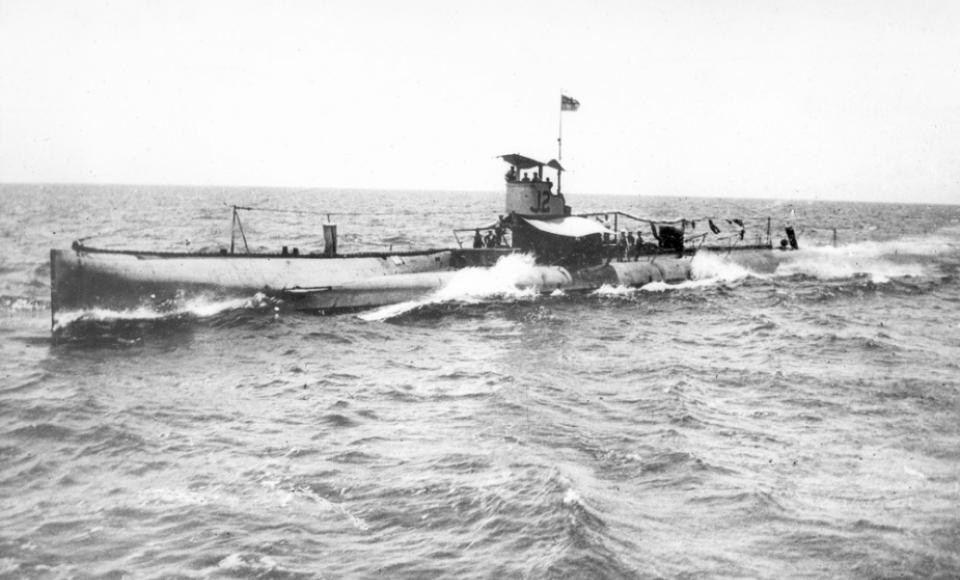Towards the end of 1914, early in the First World War, rumours circulated that new German submarines were much faster than British boats. One report gave their speed as about 22 knots.
As a result of these reports, the British Admiralty considered the idea of developing submarines with enough surface speed to work with the fleet.
The reports turned out to be incorrect, but the idea of a high-speed British submarine gained ground. This led to the development of the J class.
Originally 8 boats were planned. This was reduced to 6 and then increased to 7. As a result of these changes the boats originally intended to be J7 and J8 were renumbered in April 1915 as J3 and J4.
HMS J2 commissioned in the Royal Navy on 1 June 1916 under the command of Lieutenant Commander A M Winser RN. It was allocated to the 11th Submarine Flotilla based at Blyth, Northumberland. On 31 July 1916 J2 departed Portsmouth for Blyth.
Operation BB
In June 1917 an operation was planned to flush out enemy submarines either leaving for patrol or returning to their bases from the Atlantic. Known as Operation BB, it was planned to force enemy submarines to dive through certain areas heavily patrolled by destroyers so that they would be on the surface while passing through adjacent areas patrolled by British submarines.
The British submarines used included J1, J2, J4 and J5. During the 10 days, 15 to 24 June, 19 German submarines passed in or out of the North Sea. Twelve were homeward bound and 7 were outward bound. There were 26 sightings, and 11 attacks. Eight attacks were made by destroyers and 3 by submarines. J2 was allocated to an area extending west-south-west from the Norwegian coast off Stavanger but saw nothing of the enemy.
At 7.40 am on 7 July 1917, when on the surface in position 58°N, 03°05´E, J2 sighted an enemy submarine also on the surface at 4500 yards. J2 fired 4 torpedoes. A column of black smoke appeared in the vicinity of the enemy’s conning tower. The enemy remained in sight for a few seconds and then disappeared. No explosion was heard on J2’s bridge or in the torpedo room, though one was heard in the engine room. At the time a hit was not allowed, though U-99, which according to German records was in the area at that time, did not return from patrol.
At 8 am on 2 August 1917, J2 sighted some ships while heading to its patrol area. The submarine dived and the commanding officer commenced an attack. On discovering that the ships were British the attack was broken off. The commanding officer decided to bottom in 125 feet until they were clear. Even so, the destroyers gained contact and attacked with depth charges, several attacks were quite close, and some damage was done. The submarine remained stationary and silent on the bottom and by 3.30 pm the surface ships had lost contact and gone away. J2 surfaced and resumed its patrol.
In 1918 J2 was sent to Liverpool to refit and was there when the Armistice was signed.
Commissioning into the Royal Australian Navy
After the First World War, the Admiralty presented the 6 remaining boats of the J class to the Australian Government. J6 had been sunk in error in 1918 by a British ship.
All the submarines commissioned into the Royal Australian Navy at Portsmouth on 25 March 1919, as tenders to the submarine depot ship HMAS Platypus. The commanding officer of J2 was Lieutenant Claud B Barry DSO RN.
The beam tubes were removed from all 6 J class submarines before they sailed for Australia. The tubes were sent separately to Garden Island. The reasons was that the beam tubes were not a success, and more accommodation was needed.
On 9 April 1919 Platypus and the submarines, escorted by the light cruiser HMAS Sydney, sailed from Portsmouth for Australia.
Final years and decommissioning
J2 was refit at Garden Island Dockyard. It sailed on 3 May 1920 to the submarine base at Geelong, Victoria.
After uneventful service, little of which was spent at sea, J2 paid off into reserve at Westernport on 12 July 1922.
On 26 February 1924 J2 was sold to the Melbourne Salvage Syndicate. The hull was sunk 3 miles off Barwon Heads on 1 June 1926.
Specifications
 |
| Class |
J Class |
|---|---|
| Type |
Submarine |
| Pennant |
J2 |
| Builder |
Portsmouth Naval Dockyard, England |
| Launched |
6 November 1915 |
| Commissioned |
25 March 1919 |
| Decommissioned |
12 July 1922 |
| Dimensions & Displacement | |
| Displacement |
|
| Length | 275 feet 6 1/8th inches |
| Beam | 23 feet 1 1/4 inches |
| Draught | 16 feet |
| Performance | |
| Speed |
|
| Range | 4000 miles at 12 knots |
| Complement | |
| Crew | 5 officers, 40 sailors |
| Propulsion | |
| Machinery |
|
| Horsepower |
|
| Armament | |
| Guns | 1 x 4-inch gun |
| Torpedoes | 6 x 18-inch torpedo tubes - 4 bow, 2 beam |
